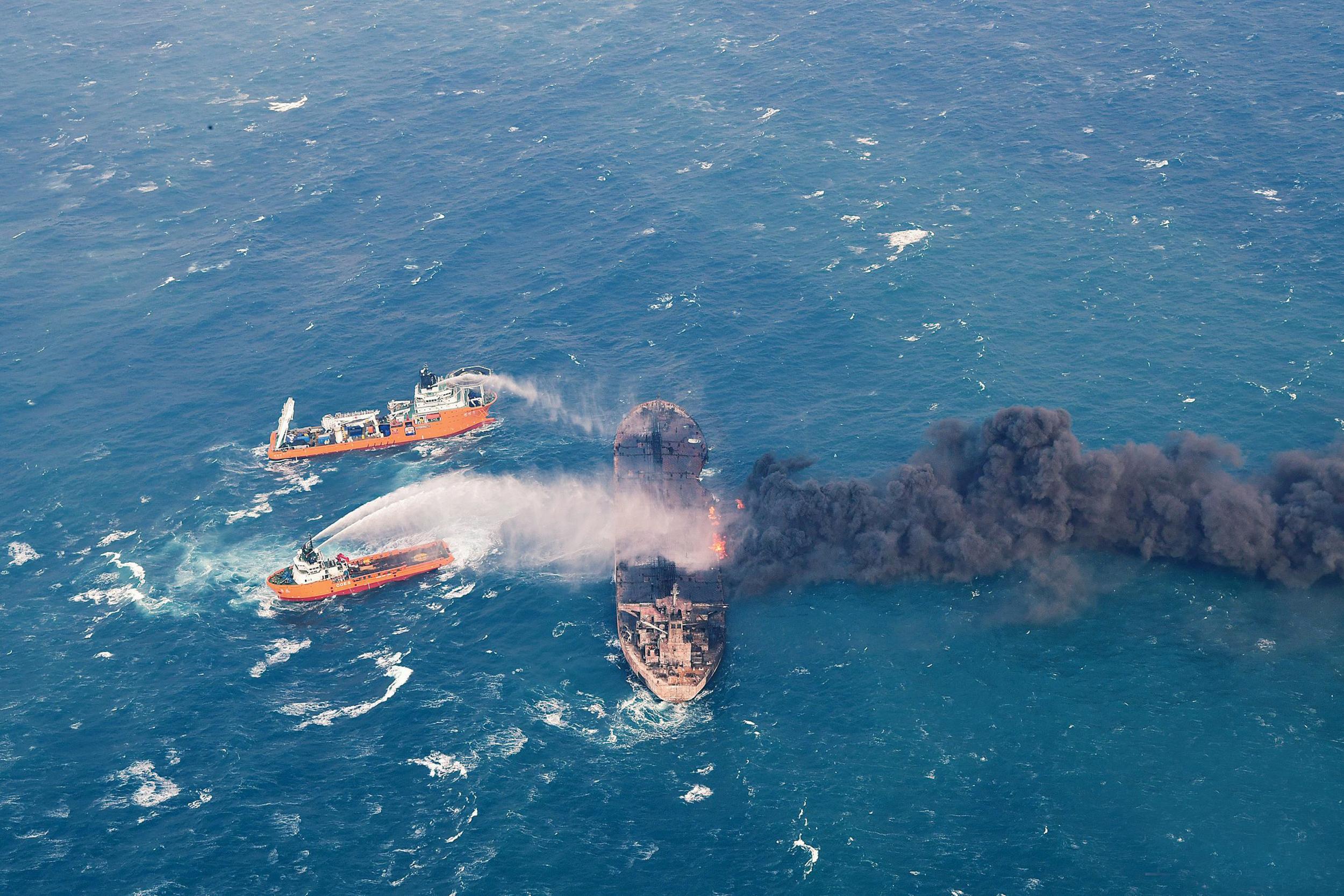Sunken Iranian tanker could cause 'irreversible' environmental damage after leaving oil slick the size of Paris
Sunken ship thought to be leaking toxic engine fuel, raising concerns for fisheries and marine wildlife

Your support helps us to tell the story
From reproductive rights to climate change to Big Tech, The Independent is on the ground when the story is developing. Whether it's investigating the financials of Elon Musk's pro-Trump PAC or producing our latest documentary, 'The A Word', which shines a light on the American women fighting for reproductive rights, we know how important it is to parse out the facts from the messaging.
At such a critical moment in US history, we need reporters on the ground. Your donation allows us to keep sending journalists to speak to both sides of the story.
The Independent is trusted by Americans across the entire political spectrum. And unlike many other quality news outlets, we choose not to lock Americans out of our reporting and analysis with paywalls. We believe quality journalism should be available to everyone, paid for by those who can afford it.
Your support makes all the difference.An Iranian oil tanker that sank in flames off the east coast of China is thought to be leaking heavy bunker fuel, raising fears of an environmental disaster.
Experts warned “irreversible” damage to marine wildlife was possible after the ship sank on Saturday, leaving behind an oil slick the size of Paris.
The Sanchi had drifted ablaze for eight days after a collision with a freighter in the East China Sea, one of the worst oil ship disasters in decades.
The tanker’s crew of 30 Iranians and two Bangladeshis are all believed to have died.
At the time of the crash, the Sanchi was carrying 136,000 tons – almost one million barrels – of condensate, an ultra-light, highly flammable crude oil.
The Chinese State Oceanic Administration (SOA) said five oil slicks with a collective area of 101sq km had been spotted on Wednesday, although they had shrunk to about a quarter of the size by the next day.
Authorities said bunker fuel, a heavy oil used in ship’s engines, was now also believed to have leaked from the vessel since it sank. The Sanchi is thought to have been carrying about 1,000 tons of bunker fuel, which is toxic to marine organisms and difficult to remove from the sea once spilled.
Experts said the scale of the environmental damage would not be clear until the volume of leaked fuel was known, but warned fisheries and marine life could be impacted for years to come.
Paul Johnston, research fellow at Greenpeace International’s Science Unit at the University of Exeter, said bunker fuel was “particularly dangerous to birds and other wildlife”, and could sometimes be fatal if encountered by whales, dolphins and porpoises.
He told The Independent: “The major impact is going to be living marine organisms that are exposed to the oil slick, which is quite a big one now. It’ll taint fish, it’ll kill fish. If cetaceans encounter it they could be at very severe risk of doing themselves some serious damage.”

Greenpeace said the ship sank in an important spawning ground for species including the hairtail, yellow croaker, chub mackerel and blue crab. The area is also on the migratory pathway of several marine mammals, such as the humpback whale, right whale and gray whale.
Babatunde Anifowose, a senior lecturer in petroleum and environmental technology at the University of Coventry, said the spill could potentially have “irreversible environmental impacts” depending on the “the state of aquatic resources prior to the oil spill”.
The mass death of fish was one worst-case scenario, Dr Anifowose said, although he stressed “this is just one of the numerous possibilities” and depended on the levels of oxygen in the waters.
“The quantity of oil spilled is key in operational response efforts and assessing the likely environmental impacts,” he added. “No two oil spill incidents can ever be the same. This oil spill case is therefore unique and would require specific assessment that depends on the baseline environmental conditions at the location.”
The SOA said it was monitoring the spill’s environment impact. Water samples taken at four of the total 22 spill sites detected so far were found to exceed petroleum substance standards.
Dr Johnston said: “There’s no such thing as a good oil spill. There’s a really strong need for monitoring activities to expand in scale so we’ve got a good picture of how the petroleum hydrocarbons are spreading in the environment, and there’s also a need for surveillance monitoring of the living marine resources there – the sorts of things people might be likely to eat.”
The Chinese transport ministry’s emergency response department said it plans to send a robot submarine, possibly followed by divers, to explore and plug holes in the ship. No timeline was given for the mission.
Depending on conditions, divers might also be able to pump oil from the vessel’s fuel tanks before they leak further and contaminate the seabed.
Authorities say the Sanchi is lying under 115m (377ft) of water in the East China Sea, about 530km (330 miles) south-east of Shanghai. Despite fears of environmental damage, the sinking is not thought likely to create oiled beaches such as those caused by the uncontrolled blowout on the Deepwater Horizon oil rig in the Gulf of Mexico in 2010.
The UK National Oceanography Centre, using a computer simulation model, predicted waters polluted by the sinking oil tanker could reach Japan within a month. However, it said the fate of the leaking oil was uncertain.
“It may contaminate beaches but I doubt it will be a thick slick,” said Dr Johnston.
Join our commenting forum
Join thought-provoking conversations, follow other Independent readers and see their replies
Comments